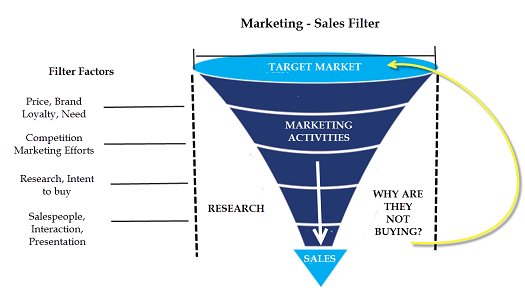Marketing vs. Sales
 The difference between marketing and sales has been hard to define for many business owners. Businesses continually argue over the importance of the two, although they often have a hard time explaining the differences and quantifying the effectiveness of each. If you ask a small business owner what he is doing for marketing and then what he is doing for sales, you will typically get the same answer for both. While marketing and sales cannot exist without each other, they are two separate activities that work hand in hand to create revenue. Many times, businesses struggle with trying to figure out which side to focus on: Marketing or Sales. This resource will outline that the key to success relies in having an optimal balance between marketing and sales.
The difference between marketing and sales has been hard to define for many business owners. Businesses continually argue over the importance of the two, although they often have a hard time explaining the differences and quantifying the effectiveness of each. If you ask a small business owner what he is doing for marketing and then what he is doing for sales, you will typically get the same answer for both. While marketing and sales cannot exist without each other, they are two separate activities that work hand in hand to create revenue. Many times, businesses struggle with trying to figure out which side to focus on: Marketing or Sales. This resource will outline that the key to success relies in having an optimal balance between marketing and sales.
The Giersch Group provides strategic consulting for small and mid-sized businesses in the greater Milwaukee & Madison areas.
Get a free consultation to learn more about our flexible services and affordable rates.
Marketing
We must first define Marketing and Sales for the purpose of this discussion, keeping in mind that they are extremely similar and at times, directly related. Marketing can be defined as all of the things you do to reach out and connect with your target market and attract them to your business. These things include, but are not limited to:
- Direct mail,
- Social media,
- Print advertising,
- Billboards,
- TV, radio and internet advertising,
- Brochures,
- Cold-calling, public speaking, trade shows, webinars and referrals,
- Writing articles, blogs and websites
- And even what the salespeople say
Marketing is a one-to-many strategy that aims to target a mass audience in as many avenues as possible. In sum, marketing is anything that can create awareness about your products, services, and company and it is a long-term investment that is intended to generate leads and prospects, which will eventually become sales and revenue for the company.
Components of Marketing
Marketing can be broken down into two categories that differ in the way that they attract customers to the business. The first is the traditional way of thinking of marketing and is called Outbound Marketing. This classic way of marketing involves more of a push strategy, where the messages are pushed to the audience by way of email blasts, cold-calling, advertising, and/or direct mail. The message is pushed out to a wide audience with the idea that people will see this information and be drawn to the company or the particular special that is being offered. This type of marketing can be expensive and have a very low response rate, mainly because money is spent pushing content to prospects that are not in the market to buy. Still, this strategy does produce leads and sales and is usually part of a comprehensive marketing strategy.
Inbound Marketing
A newer way of marketing has emerged in what is becoming known as Inbound Marketing. Customers are finding more ways to block traditional outbound marketing by enrolling in Do-Not-Call Lists, SPAM filters, throwing away “junk mail,” and changing stations when radio or TV ads come on. The Inbound Marketing concept allows potential customers to seek out businesses because they are already looking for the products and services they provide. Inbound Marketing involves optimization of the avenues that help a business get found. Search engine optimization (SEO), blogging, social media updates and posts are all ways to have a business’s website get discovered by customers who are already looking for that type of product or service. This pull strategy revolves around today’s customers being savvy, knowing what they want, and seeking out more information. While this concept is sometimes thought of as free, it is not, since it takes time and effort to continually put fresh content and keywords on websites, blogs and social media sites. Overall, it is less expensive and typically, more effective because customers are seeking out this information rather than having it pushed onto them.
Sales
Sales, then, is the process of overcoming objections and convincing prospective buyers that the products or services offered by the company will meet the needs of the customer to ultimately close the sale. Sales is generally a one-on-one activity, though the entire process may need to go through several key people within a company. Many times, sales connotes pressuring a customer to buy something that they may not need, at the price it’s being offered. In reality, sales is the process of talking to someone, listening to their business problems and then showing them how your business’s product or service is the best solution to their problems. By getting a customer to engage, a salesperson is able to listen and learn about all of the issues and activities that are important to that business or individual. Just getting to know someone by learning who they are and what they do will allow salespeople to identify ways their business can help. This process will identify whether there is a need or potential need in the future for a product or service, or if there really is no connection at all.
Things salespeople say during this process and the materials used are actually part of marketing, which is why many times business owners are confused about the differences between sales and marketing. While the marketing aspect of the content and information presented is important, the actual sale will usually be won through the personal interaction and relationship building.
Creating Balance between Marketing and Sales
Many businesses struggle to define marketing and sales, but also look to try to focus on one over the other. These two concepts work in concert together – you cannot have one without the other. Businesses should try to focus on creating the right balance between the two. At different times, owners will need to determine whether they need to be developing a bigger awareness and cultivating new prospects or closing sales. Businesses go through highs and lows and, depending on the sales pipeline at a given time, will need to focus more on one than the other. Other factors contribute to the selling landscape such as changes in the economy, buying trends, entering new markets and creating niche markets.
Most often, the connection between sales and marketing is explained through the concept of a funnel. Marketing is represented by the wide end of a funnel that gathers in a large audience and is responsible for creating awareness and interest, and helping to develop consideration, intent and evaluation for buyers. Sales is the small end where the actual purchase happens. However, it may be more helpful to think of this concept in terms of a filter. Not every single person will need a business’s product or service, so marketing needs to target a specific subset of the total population. Out of the people targeted then, not all will buy. Potential buyers will get filtered out through the marketing and sales process because of many factors such as other brands, other options, price, or the actual salesperson, among others.
This concept shows that the efficiency of the marketing-to-sales ratio can be measured by how wide the “in” side of the filter is, compared to the “out” side. Increased marketing activities will widen the filter, but also increase the cost of sales. If these activities are not directed (marketing to a wide, generic audience with no regard for target market), the result can be a lot of wasted money. While nearly impossible, the ideal situation would be a straight pipe where every prospect touched would come out the other end as a sale. While the “out” end can be widened by sales skill development or to hire more salespeople. Businesses should still strive for the pipe model by increasing or decreasing the “in” end in conjunction with the “out.” Put into simpler terms, adjusting and refining your marketing efforts in conjunction with sales  development training will produce the highest efficiency rate in turning prospects into actual customers through sales.
development training will produce the highest efficiency rate in turning prospects into actual customers through sales.
Marketing efforts must be targeted to the correct audience in order to produce sales. Market research needs to be done in order to understand the market a business is trying to sell to. A business should be gathering data from their current clients in order to understand what has been done correctly. Collecting data from current clients is critical to defining the target market and prospective buyers. Once a company understands their target market, defined as who is most likely to buy their products or services, they may realize that they’ve been trying to market to the entirely wrong prospects. Marketing is not effective if it is being presented to people who will never buy. They should also be surveying prospects who entered the sales process, but did not end up buying, in order to understand what aspects of their marketing plan are most effective. Many small business owners do not do this and in turn, do not know why clients are buying or why they are not. This leads to wasted money through a trial and error process.
Sales efforts must be combined with the marketing efforts. While marketing generally leads to prospects coming in, it does not suddenly go away once the personal interaction begins. Marketing can enhance the sales process through:
- Sales training
- Competitive data
- Making the sale easier by suggesting a solution
The things a salesperson says during the actual sales process is also marketing. The role of sales is to engage the prospect through personal interaction and close the sale. When marketing efforts are targeted and bring in prospects with a higher probability of buying, closing sales and creating revenue becomes more efficient. These concepts work directly together as a process, with a sale as the end result.
Businesses often struggle with finding the right balance between marketing and sales. Owners must realize that these are two distinct functions. There are times when they will need to focus on creating awareness and prospecting new leads and other times where they should focus on closing deals that their marketing efforts have already primed.
Conclusion
Marketing and sales are two separate functions within a company, but cannot exist without each other. The two areas must interact with each other regularly and efficiently in order to maximize profits. Knowing that a difference exists between marketing and sales is the first step, and knowing which function to focus on relies on the funnel. If there are no prospects coming in, there is a problem with marketing. If there are a lot of prospects coming in, but no correlating closed sales, the problem is with selling. Once a business realizes which function to focus on, its efforts can be concentrated on making the marketing-sales funnel as efficient as possible.
Get a free initial consultation with the Giersch Group to learn how our affordable services can help you grow your business.
